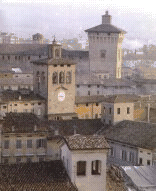 It is very important from the social and economic point of view and has the highest number of inhabitants after Reggio Emilia, the capital of the province, from which it is 15 Km away. The municipal area, situated where the hill area meets the plain, is one of the oldest human settlements in the province, and is a site of great archaeological, historical and cultural interest.
It is very important from the social and economic point of view and has the highest number of inhabitants after Reggio Emilia, the capital of the province, from which it is 15 Km away. The municipal area, situated where the hill area meets the plain, is one of the oldest human settlements in the province, and is a site of great archaeological, historical and cultural interest.
ALL FILES OF SCANDIANO
- San Giuseppe Fair - March 19
- Post code: 42019
- Market days: Monday and Wednesday
Inhabitants:
24,884 update Dicember, 31 2009 |
How to get there:
From A1 motorway Reggio Emilia exit, take SS 467 ring-road towards Scandiano-Sassuolo; from Modena, take SS 486 "Passo delle Radici" road towards Sassuolo, then at Veggia take SS 467 road towards Scandiano-Reggio Emilia. By train: there are local trains for Scandiano-Sassuolo which leave from Reggio Emilia Station; there is also the ACT bus service. |
Tourist information:
phone 0039/522/764211 - Municipality |
The famous "Venere" (found in 1940 and now conserved in the Reggio Emilia's Civic Museum) comes from the Neolithic village of Chiozza di Scandiano. The first castle in Scandiano was built in 1262 by Gilberto Fogliani from the same famous family as Guido Riccio, immortalised by the brush of Simone Martini in Siena. The Estensi family succeeded the Fogliani family who were in turn succeeded by the Boiardo family (1432), the most famous of whom was the poet Matteo Maria. When the last Boiardo, Ippolito, died in 1560, Scandiano became part of the Estense duchy estate: several investitures followed, the Thiene family, the Bentivoglio family, the Mari family, then passing under the direct rule of the Estensi family until the Risorgimento period (with the exception of the periods during the Cispadana and Cisalpina Republics and the Italico Kingdom). Nowadays Scandiano is a thriving agricultural, commercial and industrial centre thanks also to its position at the foot of the hills and at the access point to the Apennine valleys. The ceramic industry is particularly important. The wines of Scandiano are much appreciated.
Scandiano preserves interesting traces of its noble past: the Boiardo Fortress, a grand renaissance construction with an exterior which was unfortunately never completed and whose interior has been divested of frescoes by Nicolò dell'Abate (16th century), now on display in the Modena Art Gallery. The parochial church preserves tombstones of numerous members of the city's feudal families. The St. Giuseppe Church has a beautiful altar sculptured in wood, with a choir, by Cecati and remains of frescoes attributed to Nicolò dell'Abate. Other points of interest include the Clock Tower, the ancient entrance to the Fortress and the birthplace of Spallanzani which has a charmingly modest typical eighteenth century facade. In the main square, surrounded by ancient porticoes, there is a beautiful statue of Spallanzani, the work of G. Fornaciari. There have been many illustrious citizens of Scandiano. These include Matteo Maria Boiardo (1441-1496), one of the great Italian poets, and, the innovator of Italian epic heroic poetry with his Orlando Innamorato; Antonio Vallisneri (1661-1730), distinguished scientist, pupil of Malpighi; Lazzaro Spallanzani (1711-1778), naturalist and physiologist, described by Pasteur as "one of the greatest experimenters who ever lived and one of the true glories of Italy!"